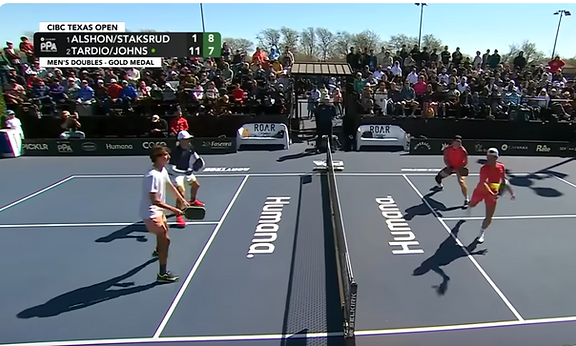9 Hit Fire Fight
Alshon initiates the fire fight with a flick towards Johns at 1740.76 seconds into the video. Johns returns the ball at 1741.09 seconds for an elapsed time of 0.33 seconds. The fire fight continues with an average elapsed time of about 0.35 seconds between each hit. What is amazing is that the players can react to the oncoming ball and position their paddle for a return during that time. The average reaction time is about 0.22 seconds and that leaves one-tenth of a second to move the paddle into hitting position and swing.
The ball travels about 16 feet as each team is planted near their respective kitchen lines. The average ball speed is 31 mph. Due to aerodynamic drag, the ball, as it leaves the paddle, is moving at 35 mph and reaches the opponent traveling at 28 mph.
The paddle speed creating that shot can be calculated using the Equation of Motion.
Vrebound = eA * Vinbound + (1+eA) * Vpaddle
rearranging -
Vpaddle=Vrebound/(1+eA)-(eA/(1+eA))*Vinbound
where Vrebound=35
Vinbound=28
eA=0.26
Vpaddle = 22 mph
Core Crushed Illegal Paddle
What happens when the opponent is using a core-crushed illegal paddle? Again, the Equation of Motion is used, but with a different value of eA for an illegal paddle (my broken Pulse V mentioned in Break In).
Vrebound = eA * Vinbound + (1+eA) * Vpaddle
where Vpaddle=22
Vinbound=28
eA=0.35
Vrebound = 39.5
Thus, the ball velocity off the paddle face increases to 39.5 mph with an illegal paddle vs 35 mph with a legal paddle or a 12% velocity increase. The time to cross the 16 foot distance between players has decreased from 0.35 seconds to 0.30 seconds by using an illegal paddle. Both agencies have done a service by instituting PBCOR testing to slow the game down and create a safe game!
